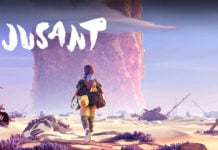
Assassins Creed Valhalla has delivered a rich dose of Viking violence to us since it was released in 2020. With two large DLC packs taking players to France and Ireland, the latest release is set to take things to a much more exotic location. An adventure that swings an axe deep into the Norse apocalypse, Ragnarok. Will this expansion be a high note to finish Eivor’s ferocious adventure or is it a step too far into fantasy?
Dawn of Ragnarok continues with the exciting side quests we saw in the base game. Eivor submerges himself deep into a vision that brings him into the realms of Norse mythology where he becomes Odin, the leader of Asgard. These quests were such a fun and colourful left field from the main Viking story that it has set the bar very high for Dawn of Ragnorok to deliver.
It is very risky trying to take a large bite out of Norse mythology as the game is naturally going to be compared against God of War. At the same time, Norse mythology is such a dense fabric of characters, locations, creatures and lore that It is quite hard to go wrong. Considering the quality of the world built in Assassins Creed Valhalla and the subsequent DLC, you would expect Dawn of Ragnarok to be a home run.
Dawn of Ragnarok gets off to a strong start, setting the tone of the story and introducing you to Surtr, the fire giant, who is the lead antagonist. Sadly, things begin to get rather dull as you get stuck into the adventure and will start to feel like this isn’t the best effort that the Assassins Creed team can produce.
When you first visit Asgard in the base game, you will be taken aback by the bright colours, towering architecture and the overall feeling of magic in the air. All of these things are absent from Dawn of Ragnarok. The rather large fiery tree roots are seen from across the map certainly signal that this isn’t Kansas anymore but this is where any feelings of any magical grandiose end.

The landscape does not feel foreign enough. Remove a few of the floating stones and the dwarf statues and this could be some island off the coast of England. This is not acceptable for what should be the pinnacle of Assassins Creed Valhallas Norse adventure.
We are in a land populated with dwarves. A race that is known for building structures that are large and imposing. Bar some statues of dwarves that are quite large but not quite massive, there is little evidence that this land is a place of any importance.

Before you even focus on the story, you will notice something feels a little wrong with the environment in general. No unusual creatures or weird things going on. Wolves, deer and most of the same animals you have seen time and time again are running around. I did encounter one metal boar but never found one again. With the exception of the blue glow from the Hugr flowers, the wild animals and plants are just recycled from England. Nothing magical about any trees or some strange creatures to help you feel like you are far away from home.

Hugr-rip abilities are a new addition to the gameplay and combat that provide some interesting mechanics. These abilities are ripped from dead enemies and will give you unique powers like walking on lava, reviving dead enemies to fight for you and even turning into a bird to quickly traverse the environment.
These abilities are interesting but you can only hold two at a time. If you find yourself wanting the ability to turn into a bird but dropped it, you will have to go searching for it. This makes these skills hard to rely on and in turn, prevents you from being able to really enjoy them. If we could keep them all and select them similar to the ranged and melee combat abilities we got from books of knowledge, it would have allowed for more unique and unusual puzzles across the map. Instead, you will only need to use these when the campaign wants you to, and even then, you will always find the ability you need nearby. Feels like a wasted opportunity.

The main enemies you are going to encounter are the flaming minions of Surtr and the blue Jotunn giants that you will be familiar with from the earlier quests. They have been destroying the land, driving away the dwarves by scorching villages and capturing strategic buildings. This is where the standard model of Assassins Creed fits in. Drive off the enemies in various locations to get some useful resources for crafting as a reward.
While these crafting components are useful to obtain, it will be much later in the game before you get the best upgrades at which point you have to ask, what use is this gear when there is nothing left to do?
Raids were a big part of the core game and they are also part of the Ragnarok expansion. When you first call a boat of raiders, you might expect them to come sailing on a floating boat with wings or something very mythical. The reality is much like the landscape, recycled!
When you see a boat full of regular old Vikings show up, it feels like a missed opportunity. It doesn’t make much sense that a standard Viking longboat of run of the mill soldiers would even exist in this place to begin with. Give me some kind of flying boat filled with warriors who made it to Valhalla!

The raids themselves lack the scale and fun that we saw in the core game. They quickly become a bit of a core to grind the crafting resources that you might use for upgrades.
The main story is a little more exciting and it does deliver more of the magical elements that the world is so desperately missing but it just isn’t enough. When the three quests available in the base game around the mythology delivered more magic and foreign aesthetics, you can’t help but feel like this entire expansion falls way too short of what it could have been.

Dawn of Ragnarok is by no means a bad game, the expansion delivers a lot of was good about the core game. But when it comes to Norse mythology, you have so much source material to work with and could visit anywhere in the nine realms to deliver a memorable adventure. Why do we visit some random countryside with very little to see? We have already seen Asgard, the bar is far too high for this to be the big finale. A couple of golden mountains and statues littered across the English countryside don’t suddenly make it a strange new land.
























